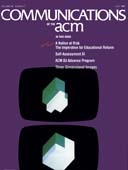In the changing computer world of multiple opportunities, the greatest difficulty lies in deciding which of the many possible dreams to strive for, what goals to set. The IEEE Computer Society and the Association for Computing Machinery, the two largest and fastest growing professional organizations in the computer field, have come to share more or less independently, a great number of common objectives. The distinction between the two societies is no longer clear. What might once have been a clear separation of interest and programs is now a continuum with most of our activities intertwined.
July 1983 - Vol. 26 No. 7

Features
Human factors guidelines for terminal interface design
This paper provides a set of guidelines for the design of software interfaces for video terminals. It describes how to optimize screen layouts, interactive data entry, and error handling, as well as many practical techniques for improving man-machine interaction. Emphasis is placed on factors relating to perceptual and cognitive psychology rather than on gross physiological concerns. Ways in which interfaces can be evaluated to improve their user friendliness are also suggested. The author summarizes many ideas that can be found in other, more comprehensive texts on the subject. These guidelines will provide practicing software designers with useful insights into some of today's principal terminal interface design considerations.
Natural command names and initial learning: a study of text-editing terms
In the first of two studies of “naturalness” in command names, computer-naive typists composed instructions to “someone else” for correcting a sample text. There was great variety in their task-descriptive lexicon and a lack of correspondence between both their vocabulary and their underlying conceptions of the editing operations and those of some computerized text editors. In the second study, computer-naive typists spent two hours learning minimal text-editing systems that varied in several ways. Lexical naturalness (frequency of use in Study 1) made little difference in their performance. By contrast, having different, rather than the same names for operations requiring different syntax greatly reduced difficulty. It is concluded that the design of user-compatible commands involves deeper issues than are captured by the slogan “naturalness.” However, there are limitations to our observations. Only initial learning of a small set of commands was at issue and generalizations to other situations will require further testing.
A hierarchical data structure for multidimensional digital images
A tree data structure for representing multidimensional digital binary images is described. The method is based on recursive subdivision of the d-dimensional space into 2d hyperoctants. An algorithm for constructing the tree of a d-dimensional binary image from the trees of its (d - 1 )-dimensional cross sections is given. The computational advantages of the data structure and the algorithm are demonstrated both theoretically and in application to a three-dimensional reconstruction of a human brain.
The k-distribution of generalized feedback shift register pseudorandom numbers
A necessary and sufficient condition is established for the generalized feedback shift register (GFSR) sequence introduced by Lewis and Payne to be k-distributed. Based upon the theorem, a theoretical test for k-distributivity is proposed and performed in a reasonable amount of computer time, even for k = 16 and a high degree of resolution (for which statistical tests are impossible because of the astronomical amount of computer time required). For the special class of GFSR generators considered by Arvillias and Maritsas based on the primitive trinomial Dp + Dq + 1 with q = an integral power of 2, it is shown that the sequence is k-distributed if and only if the lengths of all subregisters are at least k. The theorem also leads to a simple and efficient method of initializing the GFSR generator so that the sequence to be generated is k-distributed.
Precision averaging for real-time analysis
An analysis of the computation of the arithmetic mean using only single-precision fixed-point arithmetic is presented. This is done to ease the timing constraints common to many on-line applications. Others have introduced several averaging algorithms in floating-point arithmetic for use in inferential statistics. In this paper, these algorithms are evaluated with respect to their feasibility as fixed-point methods in the context of real-time analysis. Modifications of these algorithms are presented, and previously unpublished ones are introduced in the interest of avoiding overflow (necessary) and minimizing truncation errors (highly desirable). All algorithms presented are tested for speed and accuracy on several sets of data, including their own “worst case.” The applicability of each algorithm is discussed with respect to some of the basic functions that real-time programs must perform.



